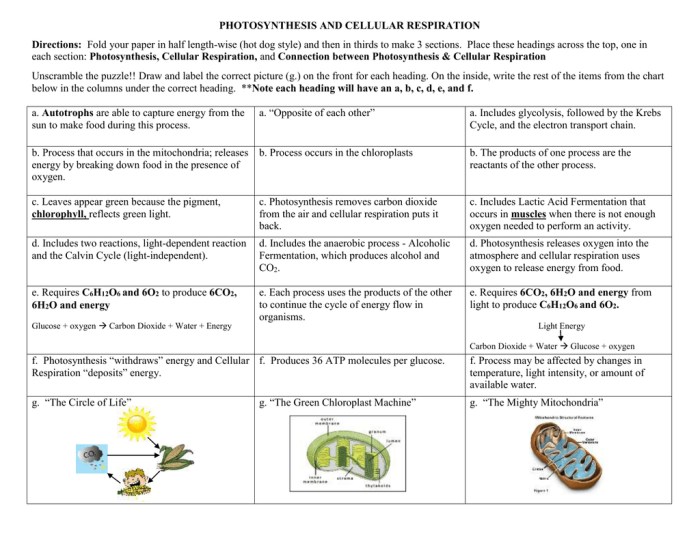Embark on a scientific odyssey with our comprehensive Cellular Respiration POGIL Answer Key, a definitive guide to unlocking the mysteries of cellular energy production. Dive into the intricate processes that fuel life, from glycolysis to oxidative phosphorylation, and uncover the fundamental principles that govern this vital metabolic pathway.
Through detailed explanations, illustrative diagrams, and thought-provoking questions, this answer key empowers students and educators alike to grasp the complexities of cellular respiration, empowering them to unravel the secrets of life’s energy currency.
1. Cellular Respiration Overview: Cellular Respiration Pogil Answer Key

Cellular respiration is a fundamental metabolic process that occurs in all living cells. It is the process by which cells convert chemical energy stored in glucose and other organic molecules into ATP, the primary energy currency of cells.
The overall chemical equation for cellular respiration is:
“`C6H12O6 + 6O2 → 6CO2 + 6H2O + energy (as ATP)“`
This equation shows that one molecule of glucose is combined with six molecules of oxygen to produce six molecules of carbon dioxide, six molecules of water, and a large amount of energy in the form of ATP. This energy is used to power various cellular activities, including muscle contraction, protein synthesis, and cell division.
2. Glycolysis
Glycolysis is the first step of cellular respiration. It occurs in the cytoplasm of the cell and involves the breakdown of glucose into two molecules of pyruvate.
The steps of glycolysis are as follows:
- Glucose is phosphorylated to form glucose-6-phosphate.
- Glucose-6-phosphate is isomerized to fructose-6-phosphate.
- Fructose-6-phosphate is phosphorylated to form fructose-1,6-bisphosphate.
- Fructose-1,6-bisphosphate is cleaved into two molecules of glyceraldehyde-3-phosphate (G3P).
- G3P is oxidized to form 1,3-bisphosphoglycerate (BPG).
- BPG is dephosphorylated to form 3-phosphoglycerate (3PG).
- 3PG is isomerized to 2-phosphoglycerate (2PG).
- 2PG is dehydrated to form phosphoenolpyruvate (PEP).
- PEP is dephosphorylated to form pyruvate.
The energy yield of glycolysis is 2 molecules of ATP and 2 molecules of NADH.
3. Pyruvate Oxidation and Citric Acid Cycle
Pyruvate oxidation is the second step of cellular respiration. It occurs in the mitochondrial matrix and involves the conversion of pyruvate into acetyl-CoA.
The steps of pyruvate oxidation are as follows:
- Pyruvate is decarboxylated to form acetaldehyde.
- Acetaldehyde is oxidized to form acetyl-CoA.
The citric acid cycle is the third step of cellular respiration. It also occurs in the mitochondrial matrix and involves the oxidation of acetyl-CoA to produce CO2 and energy.
The steps of the citric acid cycle are as follows:
- Acetyl-CoA is condensed with oxaloacetate to form citrate.
- Citrate is isomerized to isocitrate.
- Isocitrate is oxidized to form α-ketoglutarate.
- α-Ketoglutarate is decarboxylated to form succinyl-CoA.
- Succinyl-CoA is converted to succinate.
- Succinate is oxidized to form fumarate.
- Fumarate is hydrated to form malate.
- Malate is oxidized to form oxaloacetate.
The energy yield of the citric acid cycle is 2 molecules of ATP, 3 molecules of NADH, and 1 molecule of FADH2.
4. Electron Transport Chain and Oxidative Phosphorylation, Cellular respiration pogil answer key
The electron transport chain is a series of protein complexes located in the inner mitochondrial membrane. It is responsible for the transfer of electrons from NADH and FADH2 to oxygen.
The electron transport chain is composed of four complexes: complex I, complex II, complex III, and complex IV. Electrons are passed from complex I to complex II to complex III to complex IV. As electrons are passed through the electron transport chain, they lose energy, which is used to pump protons across the inner mitochondrial membrane.
Oxidative phosphorylation is the process by which the energy stored in the proton gradient is used to synthesize ATP. Oxidative phosphorylation occurs in the ATP synthase complex, which is located in the inner mitochondrial membrane.
The energy yield of oxidative phosphorylation is 32-34 molecules of ATP.
Question & Answer Hub
What is the overall chemical equation for cellular respiration?
C6H12O6 + 6O2 → 6CO2 + 6H2O + energy
Where does glycolysis occur within the cell?
Cytoplasm
What is the role of NADH and FADH2 in cellular respiration?
Electron carriers that donate electrons to the electron transport chain